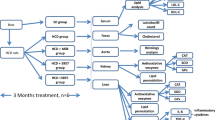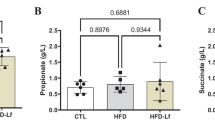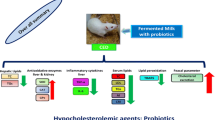Abstract
We recently identified a novel probiotic strain Lactobacillus plantarum P-8 (L. plantarum P-8), which has been characterized in detail with regard to its probiotic potential. In the present study, soymilk fermented with L. plantarum P-8 was examined for its effects on diet-induced hyperlipidemia in Wistar rats. The experimental animals were divided into four groups: control group (C group), model group (M group), soymilk group (SM group) and fermented soymilk group (FSM group). The serum lipid levels, hepatic fat deposition, serum oxidative stress parameters, hepatic marker enzymes levels, organ indices, gut bacteria and fecal fat contents were analyzed. Fermented soymilk reduced the concentration of total cholesterol (TC), triglyceride (TG) and low-density lipoprotein cholesterol (LDL-C) in serum, with a significant elevation in high-density lipoprotein cholesterol (HDL) concentration. Our results also suggested the beneficial effects of fermented soymilk on the liver function, hyperlipidemia-induced oxidative stress and intestinal bacteria. Moreover, fermented soymilk could enhance the fecal excretion of TC, TG and bile acids. These findings demonstrated that soymilk fermented with L. plantarum P-8 was effective in improving the lipid metabolism in hyperlipidemic rats. The hypolipidemic effect of fermented soymilk was partly due to the inhibition of dietary fats absorption and regulation of fecal fats excretion mediated by gut bacteria.


Similar content being viewed by others
Abbreviations
- L. plantarum :
-
Lactobacillus plantarum
- TC:
-
Total cholesterol
- TG:
-
Triglyceride
- LDL-C:
-
Low-density lipoprotein cholesterol
- HDL-C:
-
High-density lipoprotein cholesterol
- CFU:
-
Colony forming units
- ALT:
-
Alanine aminotranferease
- AST:
-
Aspartate aminotransferase
- MDA:
-
Malondialdehyde
- SOD:
-
Superoxide dismutase
- GSH-Px:
-
Glutathione peroxidase
- T-AOC:
-
Total anti-oxidant capacity
- TBA:
-
Total bile acids
- C group:
-
Control group
- M group:
-
Model group
- SM group:
-
Soymilk group
- FSM group:
-
Fermented soymilk group
References
C.S. Fox, P. Muntner, Trends in diabetes, high cholesterol, and hypertension in chronic kidney disease among U.S. adults: 1988–1994 to 1999–2004. Diabetes Care 31, 1337–1342 (2008)
N.N. Mehta, Y. Yu, R. Pinnelas, P. Krishnamoorthy, D.B. Shin, A.B. Troxel, J.M. Gelfand, Attributable risk estimate of severe psoriasis on major cardiovascular events. Am. J. Med. 124, 775.e1–775.e6 (2011)
A.F. Vuorio, P.T. Kovanen, Do statins reduce the incidence of stroke in familial hypercholesterolemia? Expert. Rev. Cardiovasc. Ther. 9, 349–353 (2011)
C. Gentil, S. Le Jan, J. Philippe, J. Leibowitch, P. Sonigo, S. Germain, F. Piétri-Rouxel, Is oxygen a key factor in the lipodystrophy phenotype? Lipid Health Dis. 5, 27 (2006)
T.P. Novgorodtseva, T.A. Kantur, Y.K. Karaman, M.V. Antonyuk, N.V. Zhukova, Modification of fatty acids composition in erythrocytes lipids in arterial hypertension associated with dyslipidemia. Lipid Health Dis. 10, 18 (2011)
J.A. Lardizabal, P. Deedwania, Lipid-lowering therapy with statins for the primary and secondary prevention of cardiovascular disease. Cardiol. Clin. 29, 87–103 (2011)
N. Tada, N, fibrates, clinical use and their effects. Nihon Rinsho Suppl. 1(614–620) (2011)
V. Soska, Residual risk of cardiovascular complications and its reduction with a combination of lipid lowering agents. Vnitr. Lek. 57, 313–316 (2011)
R.C. Gillett Jr., A. Norrell, Considerations for safe use of statins: liver enzyme abnormalities and muscle toxicitiy. Am. Fam. Physician 83, 711–716 (2011)
M. Molokhia, P. McKeigue, V. Curcin, A. Majeed, Statin induced myopathy and myalgia: time trend analysis and comparison of risk associated with statin class from 1991–2006. PLoS One 3, e2522 (2008)
A. Unal, E. Torun, M.H. Sipahioglu, B. Tokgoz, M.G. Kaya, O. Oymak, C. Utas, Fenofibrate-induced acute renal failure due to massive rhabdomyolysis after coadministration of statin in two patients. Intern. Med. 47, 1017–1019 (2008)
D. Laurin, H. Jacques, S. Moorjani, F.H. Steinke, C. Gagné, D. Brun, P.J. Lupien, Effects of a soy-protein beverage on plasma lipoproteins in children with familial hypercholesterolemia. Am. J. Clin. Nutr. 54, 98–103 (1991)
E.M. Kurowska, J. Jordan, J.D. Spence, S. Wetmore, L.A. Piché, M. Radzikowski, P. Dandona, K.K. Carroll, Effects of substituting dietary soybean protein and oil for milk protein and fat in subjects with hypercholesterolemia. Clin. Invest. Med. 20, 162–170 (1997)
S.C. Ho, J.L. Woo, S.S. Leung, A.L. Sham, T.H. Lam, E.D. Janus, Intake of soy products is associated with better plasma lipid profiles in the Hong Kong Chinese population. J. Nutr. 130, 2590–2593 (2000)
S.T. Chen, S.H. Ferng, C.S. Yang, S.J. Peng, H.R. Lee, J.R. Chen, Variable effects of soy protein on plasma lipids in hyperlipidemic and normolipidemic hemodialysis patients. Am. J. Kidney Dis. 46, 1099–1106 (2005)
N.R. Matthan, S.M. Jalbert, L.M. Ausman, J.T. Kuvin, R.H. Karas, A.H. Lichtenstein, Effect of soy protein from differently processed products on cardiovascular disease risk factors and vascular endothelial function in hypercholesterolemic subjects. Am. J. Clin. Nutr. 85, 960–966 (2007)
A.S. Santo, A.M. Santo, R.W. Browne, H. Burton, J.J. Leddy, S.M. Horvath, P.J. Horvath, Postprandial lipemia detects the effect of soy protein on cardiovascular disease risk compared with the fasting lipid profile. Lipids 45, 1127–1138 (2010)
T.D. Nguyen, J.H. Kang, M.S. Lee, Characterization of Lactobacillus plantarum PH04, a potential probiotic bacterium with cholesterol-lowering effects. Int. J. Food Microbiol. 113, 358–361 (2007)
T.Y. Tsai, L.H. Chu, C.L. Lee, T.M. Pan, Atherosclerosis-preventing activity of lactic acid bacteria-fermented milk-soymilk supplemented with Momordica charantia. J. Agric. Food Chem. 57, 2065–2071 (2009)
J. Jeun, S. Kim, S.Y. Cho, H.J. Jun, H.J. Park, J.G. Seo, M.J. Chung, S.J. Lee, Hypocholesterolemic effects of Lactobacillus plantarum KCTC3928 by increased bile acid excretion in C57BL/6 mice. Nutrition 26, 321–330 (2010)
N. Xie, Y. Cui, Y.N. Yin, X. Zhao, J.W. Yang, Z.G. Wang, N. Fu, Y. Tang, X.H. Wang, X.W. Liu, C.L. Wang, F.G. Lu, Effects of two Lactobacillus strains on lipid metabolism and intestinal microflora in rats fed a high-cholesterol diet. BMC Complement Altern. Med. 11, 53 (2011)
Y. Bao, Y. Zhang, H.P. Li, Y. Liu, S.Q. Wang, X.M. Dong, F. Su, G.Q. Yao, T.S. Sun, H.P. Zhang, In vitro screen of Lactobacillus plantarum as probiotic bacteria and their fermented characteristics in soymilk. Ann. Microbiol. 62, 1311–1320 (2012)
Y. Bao, Z.L. Wang, Y. Zhang, J.C. Zhang, L.F. Wang, X.M. Dong, F. Su, G.Q. Yao, S.Q. Wang, H.P. Zhang, Effect of Lactobacillus plantarum P-8 on lipid metabolism in hyperlipidemic rat model. Eue. J. Lipid Sci. Tech. (2012). doi:10.1002/ejlt.201100393
S.K. Jain, R. McVie, J. Duett, J.J. Herbst, Erythrocyte membrane lipid peroxidation and glycosylated hemoglobin in diabetes. Diabetes 38, 1539–1543 (1989)
C. Beauchamp, L. Fridovich, Superoxide dismutase: improved assays and an assay applicable to acrylamide gels. Ana. Biochem. 44, 276–287 (1971)
R.A. Lawrence, R.F. Burk, Glutathione peroxidase activity in selenium-deficient rat liver. Biochem. Biophys. Res. Commun. 71, 952–958 (1976)
M. Kim, H.K. Shin, The water-soluble extract of chicory influences serum and liver lipid concentrations, cecal short-chain fatty acid concentrations and fecal lipid excretion in rats. Nutrition 128, 1731–1736 (1998)
H. Zhu, F. Qu, L.H. Zhu, Isolation of genomic DNAs from plants, fungi and bacteria using benzyl chloride. Nucleic Acids Res. 21, 5279–5280 (1993)
K.J. Livak, T.D. Schmittgen, Analysis of relative gene expression data using real-time quantitative PCR and the 2(−delta delta C(T)) method. Methods 25, 402–408 (2001)
R. Kitawaki, Y. Nishimura, N. Takagi, M. Iwasaki, K. Tsuzuki, M. Fukuda, Effects of Lactobacillus fermented soymilk and soy yogurt on hepatic lipid accumulation in rats fed a cholesterol-free diet. Biosci. Biotechnol. Biochem. 73, 1484–1488 (2009)
K. Ahmed, P. Rask, A. Hurtig-Wennlof, Serum apolipoproteins, apoB/apoA-I ratio and objectively measured physical activity in elderly. Scand. Cardiovasc. J. 45, 105–111 (2011)
S. Tsimikas, Y.I. Miller, Oxidative modification of lipoproteins: mechanisms, role in inflammation and potential clinical applications in cardiovascular disease. Curr. Pharm. Des. 17, 27–37 (2011)
S.A. Kumar, V. Sudhahar, P. Varalakshmi, Protective role of eicosapentaenoate-lipoate (EPA-LA) derivative in combating oxidative hepatocellular injury in hypercholesterolemic atherogenesis. Atherosclerosis 189, 115–122 (2006)
R.E. Ley, P.J. Turnbaugh, S. Klein, J.I. Gordon, Microbial ecology: human gut microbes associated with obesity. Nature 444, 1022–1023 (2006)
Y.H. Park, J.G. Kim, Y.W. Shin, H.S. Kim, Y.J. Kim, T. Chun, S.H. Kim, K.Y. Whang, Effects of Lactobacillus acidophilus 43121 and a mixture of Lactobacillus casei and Bifidobacterium longum on the serum cholesterol level and fecal sterol excretion in hypercholesterolemia-induced pigs. Biosci. Biotechnol. Biochem. 72, 595–600 (2008)
J.Z. Xiao, S. Kondo, N. Takahashi, K. Miyaji, K. Oshida, A. Hiramatsu, K. Iwatsuki, S. Kokubo, A. Hosono, Effects of milk products fermented by Bifidobacterium longum on blood lipids in rats and healthy adult male volunteers. J. Dairy Sci. 86, 2452–2461 (2003)
Acknowledgements
This research was supported by National Natural Science Foundation of China (Grant No. 31025019), the Innovation Team Development of the Ministry of Education of China (Grant No. IRT0967).,Hi-Tech Research and Development Program of China (863 Planning, Grant No.2011AA100901,2011AA100902), the Earmarked Fund for Modern Agro-industry Technology Research System (Grant No. nycytx-0501) and National Basic Research Program of China (973 Program) (2012CB720802).
Author information
Authors and Affiliations
Corresponding author
Additional information
Zhanli Wang and Yan Bao have contributed equally to this study.
Rights and permissions
About this article
Cite this article
Wang, Z., Bao, Y., Zhang, Y. et al. Effect of Soymilk Fermented with Lactobacillus plantarum P-8 on Lipid Metabolism and Fecal Microbiota in Experimental Hyperlipidemic Rats. Food Biophysics 8, 43–49 (2013). https://doi.org/10.1007/s11483-012-9282-z
Received:
Accepted:
Published:
Issue Date:
DOI: https://doi.org/10.1007/s11483-012-9282-z




